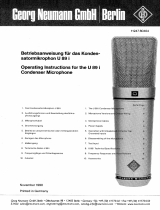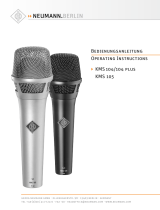
5
4
ACAC
ACAC
AC
22 (0.3 m)22 (0.3 m)
22 (0.3 m)22 (0.3 m)
22 (0.3 m) ........................................................ Cat. No. 06598
Adapter cable with a 5-pin XLR connector on one
end and an unbalanced 3.5 mm stereo jack on the
other end. It is used to connect the 5-pin XLR out-
put of the BS 48 i-2 power supply or the MTX 191 A
matrix amplifier to units with a 3.5 mm stereo input.
It is designed for all microphones of the fet 80/100
series and KM 100 F, excluding the KM 100 and the
GFM 132.
ACAC
ACAC
AC
25 (0.3 m)25 (0.3 m)
25 (0.3 m)25 (0.3 m)
25 (0.3 m) ........................................................ Cat. No. 06600
Adapter cable with 3-pin XLR connector and a 6.3 mm
monojack, unbalanced. It is used to connect 3-pin XLR
outputs of the BS 48 i or N 48 i-2 power supplies to
units with a 6.3 mm monojack input. Designed for all
microphones of the fet 80/100 series and
KM 100 F, excluding the KM 100 output stage and
the GFM 132 boundary-layer microphone.
ACAC
ACAC
AC
27 (0.3 m)27 (0.3 m)
27 (0.3 m)27 (0.3 m)
27 (0.3 m) ........................................................ Cat. No. 06602
Y-cable with a 5-pin XLR connector and two 6.3 mm
monojacks, unbalanced. It is used to connect 5-pin
XLR outputs of the BS 48 i-2 power supply or the
MTX 191 A matrix amplifier to units with 6.3 mm
monojack inputs. Designed for all microphones of the
fet 80/100 series and KM 100 F, excluding the KM 100
and the GFM 132.
3. Power Supply
3.1 Phantom Powering
The fet 100 series microphones are phantom-pow-
ered at 48 V (P48, IEC 1938).
With phantom powering the dc from the positive sup-
ply terminal is divided via two identical resistors, one
half of the dc flowing through each audio (modula-
tion) conductor to the microphone, and returning to
the voltage source via the cable shield.Phantom pow-
ering provides a fully compatible connecting system,
since no potential differences exist between the two
audio conductors. Studio outlets so powered will there-
fore also accept dynamic microphones and ribbon mi-
crophones as well as the modulation conductors of
tube-equipped condenser microphones without the
need to switch off the dc supply voltage.
No harm is done even if a phantom power supply is
connected to an outlet which is phantom powered
from another source.
2.1 Microphone Versions and Output Wiring
TLM 103TLM 103
TLM 103TLM 103
TLM 103 .............................. ni ................................ Cat. No. 08430
The TLM 103 microphone has a matt satin finish and
is equipped with a 3-pole XLR connector. The mi-
crophone is wired per IEC 268-12 (pin conn. 130-x-
IEC 02) or DIN 45 599 I, respectively:
Modulation is connected to pins 2 and 3, the shield
to pin 1.
A sudden sound pressure rise in front of the diaphragm
causes a positive voltage to appear at pin 2.
TLM 103 mtTLM 103 mt
TLM 103 mtTLM 103 mt
TLM 103 mt ...................... blk .............................. Cat. No. 08431
As above, but with matt black finish.
2.2 Microphone Cables
The electroacoustic properties of the microphones are
not affected even by very long (Neumann) cables.
However, if cables are well over 300 m, a fall-off in
the upper frequency range becomes apparent.
Neumann offers a wide range of cables. Only a selec-
tion is presented here. Other cable lengths or cable
materials without connectors are available on request.
The following cables are available for the TLM 103
microphone:
IC 3 mtIC 3 mt
IC 3 mtIC 3 mt
IC 3 mt ................................. blk .............................. Cat. No. 06543
10 m long microphone cable, 5 mm in diameter, with
double twist (double helix) braiding as shield. Three-
pin XLR connectors, matt black. For feeding the au-
dio signal to mixing consoles, etc.
ICIC
ICIC
IC
3131
3131
31
mt (5mt (5
mt (5mt (5
mt (5
m)m)
m)m)
m) ............... blk .............................. Cat. No. 06570
5 m long microphone cable, 4.5 mm in diameter, with
double twist braiding for screening. 3-pin XLR con-
nectors, matte black. This cable is textile-braided to
avoid frictional noise due to the handling of booms or
plastic leadings (for example in windscreens).
ICIC
ICIC
IC
44
44
4
(10(10
(10(10
(10
m)m)
m)m)
m) ....................... ni ................................ Cat. No. 06547
ICIC
ICIC
IC
44
44
4
mt (10mt (10
mt (10mt (10
mt (10
m)m)
m)m)
m) ............... blk .............................. Cat. No. 06557
10 m long microphone cable, 5 mm in diameter, with
double twist braiding for screening. 3-pin XLR con-
nectors and SGCD 3 rotatable swivel mount. It has a
5/8"-27 female thread that can be fastened to tripods.
A threaded adapter for 1/2"- and 3/8" studs is includ-
ed. Designed for microphones with a thread.
2.1 Ausführungsformen und Beschaltung
des Ausganges
TLM 103TLM 103
TLM 103TLM 103
TLM 103 .............................. ni ............................... Best.-Nr. 08430
Das Mikrophon TLM 103 besitzt eine nickelmatte
Oberfläche und ist mit einem 3-poligen XLR-Steck-
verbinder ausgerüstet. Die Zuordnung der Mikrophon-
anschlüsse entspricht DIN 45 599, Kennzeichen I bzw.
IEC 268-12 (pin. conn. 130-x-IEC 02):
Die Modulationsadern liegen an Stift 2 und 3, die Ab-
schirmung an Stift 1.
Bei einem Schalldruckanstieg vor der Mikrophonmem-
bran tritt an Stift 2 eine positive Spannung auf.
TLM 103 mtTLM 103 mt
TLM 103 mtTLM 103 mt
TLM 103 mt ...................... sw ............................. Best.-Nr. 08431
Wie oben, jedoch schwarzmatte Oberfläche.
2.2 Mikrophonkabel
Die akustischen Eigenschaften der Mikrophone wer-
den auch durch sehr lange (Neumann-) Kabel nicht
beeinflußt. Erst bei Kabellängen deutlich über 300 m
macht sich ein Abfall im oberen Frequenzbereich be-
merkbar.
Neumann bietet ein vielfältiges Kabelsortiment an, von
dem hier ein Ausschnitt erwähnt wird. Andere als
die genannten Kabellängen sowie Kabelmaterial ohne
Armaturen sind auf Wunsch lieferbar.
Für das Mikrophon TLM 103 stehen folgende Kabel
zur Verfügung:
IC 3 mtIC 3 mt
IC 3 mtIC 3 mt
IC 3 mt ................................. sw ............................. Best.-Nr. 06543
10 m langes Mikrophonkabel, Durchmesser 5 mm, mit
Doppeldrallumspinnung als Abschirmung. Schwarz-
matte 3-polige XLR-Steckverbinder. Führt am Ausgang
des Netzgerätes die Modulation weiter.
ICIC
ICIC
IC
3131
3131
31
mt (5mt (5
mt (5mt (5
mt (5
m)m)
m)m)
m) ............... sw ............................. Best.-Nr. 06570
5 m langes Mikrophonkabel, Durchmesser 4,5 mm, mit
Doppeldrallumspinnung als Abschirmung. Schwarzmat-
te 3-polige XLR-Steckverbinder. Zur Vermeidung von
Reibgeräuschen bei der Verwendung an der Angel
oder an Kunststoffdurchführungen (z.B. bei Windschutz-
körben) ist das Kabel textilumsponnen.
ICIC
ICIC
IC
44
44
4
(10(10
(10(10
(10
m)m)
m)m)
m) ....................... ni ............................... Best.-Nr. 06547
ICIC
ICIC
IC
44
44
4
mt (10mt (10
mt (10mt (10
mt (10
m)m)
m)m)
m) ............... sw ............................. Best.-Nr. 06557
10 m langes Mikrophonkabel für Mikrophone mit Ge-
windeanschluß, Durchmesser 5 mm, mit Doppel-
drallumspinnung als Abschirmung. Dreh- und schwenk-
bares Stativgelenk SGCD 3 (mt), 3-polige XLR-Steck-
verbinder, der Gewindeanschluß hat 5/8"-27-Gang. Ein
Adapter für 1/2"- und 3/8"-Gewindezapfen wird mit-
geliefert.
ACAC
ACAC
AC
22 (0,322 (0,3
22 (0,322 (0,3
22 (0,3
m)m)
m)m)
m) ....................................................... Best.-Nr. 06598
Adapterkabel mit einer 5-poligen XLR-Buchse und ei-
nem 3,5 mm Stereoklinkenstecker, unsymmetrisch, für
den Anschluß des 5-poligen XLR-Ausganges des Spei-
segerätes BS 48 i-2 oder der Matrixbox MTX 191 A
an Geräte mit 3,5 mm Stereoklinkenbuchse. Vorge-
sehen für alle Mikrophone der Serien fet 80/100 und
KM 100 F mit Ausnahme der Ausgangsstufe KM 100
und des GFM 132.
ACAC
ACAC
AC
25 (0,325 (0,3
25 (0,325 (0,3
25 (0,3
m)m)
m)m)
m) ....................................................... Best.-Nr. 06600
Adapterkabel mit einer 3-poligen XLR-Buchse und ei-
nem 6,3 mm Monoklinkenstecker, unsymmetrisch, für
den Anschluß des 3-poligen XLR-Ausganges eines
Speisegerätes BS 48 i oder N 48 i-2 an Geräte mit
6,3 mm Monoklinkenbuchse. Vorgesehen für alle
fet 80/100-Mikrophone und KM 100 F mit Ausnahme
der Ausgangsstufe KM 100 und des GFM 132.
ACAC
ACAC
AC
27 (0,327 (0,3
27 (0,327 (0,3
27 (0,3
m)m)
m)m)
m) ....................................................... Best.-Nr. 06602
Y-Kabel mit einer 5-poligen XLR-Buchse und zwei
6,3 mm Monoklinkensteckern, unsymmetrisch, für den
Anschluß des 5-poligen XLR-Ausganges eines Spei-
segerätes BS 48 i-2 oder der Matrixbox MTX 191 A
an Geräte mit 6,3 mm Monoklinkenbuchsen. Vorge-
sehen für alle fet 80/100-Mikrophone und KM 100 F
mit Ausnahme von KM 100 und GFM 132.
3. Stromversorgung
3.1 Phantomspeisung
Die Mikrophone der Serie fet 100 werden mit 48 V
phantomgespeist (P48, IEC 1938).
Bei der Phantomspeisung fließt der Speisestrom vom
positiven Pol der Spannungsquelle über die elektri-
sche Mitte der beiden Modulationsadern zum Mikro-
phon. Er wird hierzu über zwei gleich große Wider-
stände beiden Tonadern gleichsinnig zugeführt. Die
Rückleitung des Gleichstroms erfolgt über den Kabel-
schirm. Zwischen beiden Modulationsadern besteht
also keine Potentialdifferenz. Daher ist mit der Phan-
tomspeisung eine kompatible Anschlußtechnik mög-
lich: Auf die Anschlußdosen können wahlweise auch
dynamische Mikrophone oder Bändchenmikrophone
sowie die Modulationskabel röhrenbestückter Konden-
satormikrophone geschaltet werden, ohne daß die
Speisegleichspannung abgeschaltet werden muß.
Der Ausgang eines Phantomspeisegerätes darf auch
auf bereits anderweitig phantomgespeiste Mikrophon-
eingänge gesteckt werden.










